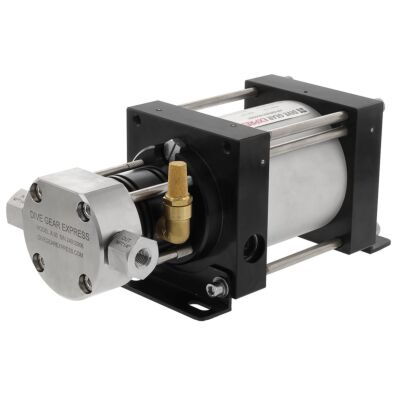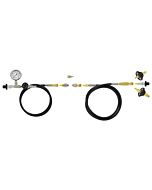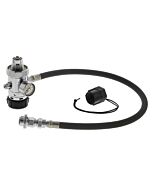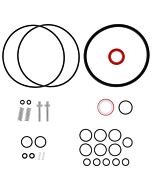DGX Gears X-30 Gas Booster
- Affordable and compact with a weight of just {16 lbs | 7.25 kg}
- Safely boost oxygen up to 3000 psi with supply pressures as low as 500 psi
- Factory cleaned for 100% Oxygen Service
DGX Gears X-30 Gas Booster
Prices include FREE continental 48 U.S. shipping!
Booster prices do NOT include international shipping, or shipping to Alaska, Hawaii, APO/FPO, or U.S. Territories.
The oil-free DGX Gears X-30 booster is a compressed air driven, reciprocating piston, single action single stage type gas booster intended for scuba diving applications. The X-30 is factory cleaned for 100% Oxygen Service. As delivered, you can use it to boost pure oxygen, but it can also boost pure helium, pure air, as well as nitrox and trimix mixtures of those gases. (Note that depending on the physical properties of the gas being boosted, efficiency and fill times can vary considerably from those of pure oxygen.) The X-30 boosters from Dive Gear Express are also factory fresh production, in-stock and immediately shipped directly to you from our warehouse.
The small size and weight allow the booster to be conveniently transported. The DGX Gears X-30 can safely boost oxygen up to 3000 psi with supply pressures as low as 500 psi. Popular with technical and rebreather divers, gas boosters allow deco & inflation bottles, oxygen and diluent rebreather cylinders to be filled when low pressure compressed air is the only source of power available. Operating with a drive air pressure of 120 psi means it can be supplied by the LP port of a SCUBA first stage regulator and tank.
For maximum flexibility, the DGX Gears Gas Booster is offered in a "naked" configuration, less fittings and hose assemblies. For our model number X-30, the inlet and outlet gas ports accept standard NPT 1/4"-18 fittings and the drive gas post accepts a standard PT/BSPT 3/8"-19 fitting. Dive Gear Express offers optional fitting and hose kits, with our DGX Gears Deluxe Fitting and Hose Kit being our most popular complete solution. If you need a low cost reliable first stage regulator for drive gas, we suggest our DGX Custom - EZ-ON Regulator Kit.
Specifications:
- Length: {11.85 In | 301mm} including mounting bracket
- Width: {4.73 in |120mm} not including hose routing
- Height: {5.12 in | 130mm}
- Weight: {16 lbs | 7.25 kg}
Operating Limitations:
- Maximum drive gas pressure: {120 PSI | 8.3 BAR}
- Maximum gas output pressure: {3480 PSI | 240 BAR}
- Minimum gas input pressure: {365 PSI | 25 BAR}
| Brand | DGX Gears |
|---|---|
| SKU | DX-X30 |
| Weight | 17.000000 |
Customer Reviews
 WARNING
WARNING
Oxygen-related fires and explosions can result in serious injury or death. This product is compatible with oxygen and factory cleaned for use with oxygen. Nonetheless, the 'clean state' of this equipment applies only prior to initial use. Thereafter, periodic inspection and cleaning are a necessity.
Best practice when boosting oxygen is to keep a low ratio between the source/target pressures and reduce the cycle speed as the ratio increases because rapid compression of oxygen also increases the risk of adiabatic combustion. Dive Gear Express recommends not exceeding a boost ratio of 5:1 and not exceeding 50 cycles per minute when boosting oxygen; lower and slower is better. It may be tempting to pull the maximum amount of gas out of the supply cylinder, but boosting low pressures can very quickly reach high boost ratios. For example, boosting from a {500 psi | 35 bar} source to a target of {2640 psi | 180 bar} is a relatively low boost ratio of about 5:1. However, a source of {300 psi | 20 bar} almost doubles the ratio to about 9:1 and an only slightly lower source of {150 psi | 10 Bar} doubles again to an 18:1 ratio.
You must meticulously follow the recommendations of the US Department of Transportation (DOT), Compressed Gas Association (CGA), and other federal/state/local agencies, plus your training agency for equipment maintenance, handling, storage, labeling, filling, transport and use of compressed gases. Ultimately, you must make the final decision to assume all risks associated with the use of any compressed gases.
Our products are intended for use in SCUBA diving related applications; they are not intended for use in medical, aerospace, or industrial applications. Purchases for use in non-diving applications are not qualified for return or refund. We are not able to supply certificates of conformance to any specific requirements or specifications such as Mil-Spec, OSHA, ISO or CE standards.
Drive Gas Options for the Booster
Our SCUBA gas boosters are normally driven with the BC inflator hose off the first stage of a diving regulator using a SCUBA tank for the source of a clean and low moisture drive gas. That allows the booster to be highly portable, operating in locations where no electrical outlet is available. Rather than a SCUBA tank, it can be more convenient and cost effective to drive the booster from a portable reciprocating single-stage piston oil-free low-pressure 'shop air' compressor powered by ordinary household electrical current, as long as the air is properly dried and filtered prior to use as a drive gas.
For a drive gas compressor, the air volume rating (typically in cubic-feet-per-minute or CFM) will determine the maximum booster cycle speed and the air pressure rating (typically pounds-per-square-inch or PSI) will determine the maximum boost pressure. In a pinch, almost any air compressor that can deliver at least 1.5 CFM will work although the booster will be quite slow and may not be able to achieve maximum boost pressure. The 3 to 6 CFM range air compressors are adequate for most boosting applications although the boost may pause occasionally while the compressor catches up and the boost cycle time will be noticeably slower approaching higher boost pressures (not necessarily a bad thing). The 7 to 10 CFM range shop air compressors with a large reservoir tank (typically configured with a 3 to 5 HP motor and 30 to 60 gallon tank) capable of maintaining a constant regulated 120 PSI will produce the best results for boosting.
Depending on ambient air conditions, the need to manually empty the compressor condensate during operation can be frequent so consider including an auto-drain feature. The design of the boosters are such that the drive gas section is separated from the boost gas section, however we strongly recommend additional moisture and particle filtration on the compressed air. If the drive gas contains moisture then it can cause corrosion to the piston rod and cylinder body, permanently damaging the booster.
With the higher volume compressors, add a variable flow control valve in the air line close to the booster itself in order to manage the cycle speed of the booster. We recommend not exceeding 50 cycles per minute continuously, but slower is better especially when boosting oxygen. The typical shop air line fitting is 1/4" NPT, so an adapter will be needed plus a high-flow quick-connect coupler compatible with the air line from the compressor.
There are a lot of sources for these kinds of compressors and accessories; home or hardware stores as well as specialty suppliers and of course on-line. We find the prices can vary considerably so it pays to shop around for the best value but you should be able to find something suitable for a few hundred dollars, although the higher end solutions are in the thousand dollar range.









